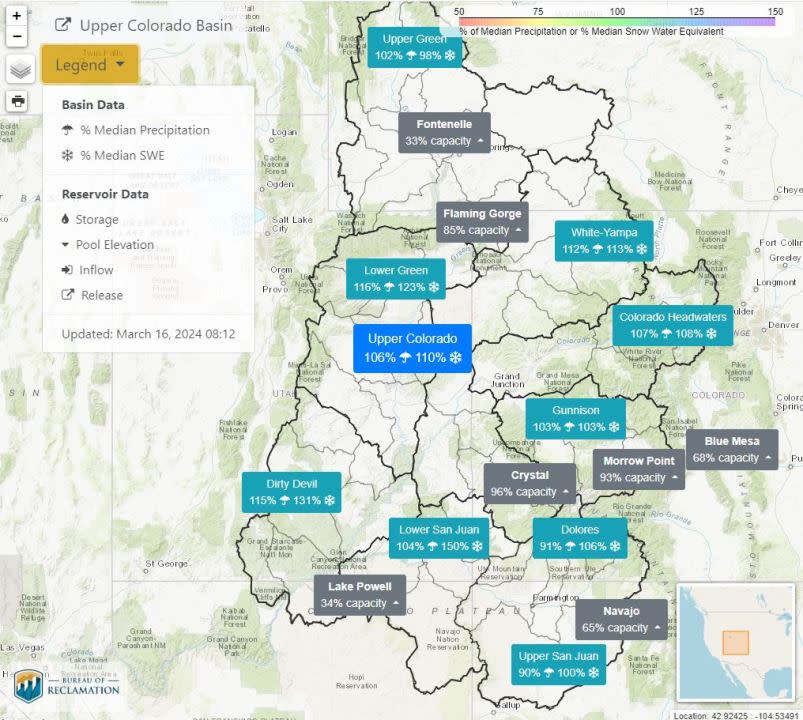Better snowpack for Colorado River may fend off ‘whiplash’ of recent years
LAS VEGAS (KLAS) — Snowfall this week in the Rockies has improved the water picture for the Colorado River, but one expert says she’s not counting her chickens before they’re hatched.
Current information on the U.S. Bureau of Reclamation’s website shows that snowpack levels in the Upper Colorado River Basin are at 110% of normal for this time of year. That’s an improvement over March 1 when it was at 101%.

Rosemary Carroll, research professor of hydrology for the Desert Research Institute (DRI), said on Friday that important weeks are still ahead, even though the snowpack peak is typically measured on April 1 each year. Reclamation’s map shows snow water equivalent (SWE) — the amount of water contained in the snow.
“It feels like the season is coming to a close, but actually March is an incredibly important portion of the year,” Carroll said. “We should get quite a bit more snow in March and even April in the headwaters of the Colorado River up in the mountains. And so a lot is still left unknown at this point.”
Carroll, who works out of the small town of Crested Butte in central Colorado, said there have been other years when hitting the average on April 1 didn’t translate into a good water year. She said that happened in 2020, a year when April snows just never came.
Snowpack that builds up in the Upper Colorado River Basin provides the water that flows down the river to Lake Powell and Lake Mead, the nation’s two largest reservoirs. Lake Mead is currently 37% full, and Lake Powell is 34% full.
But there’s reason for optimism. Projections in Reclamation’s 24-month study released on Friday have been adjusted to show about 2 1/2 feet more water in Lake Mead than previously projected for the end of November this year, and about 5 feet more by January of 2026. Lake Mead’s projected low point in June of next year — 1,044.01 feet — is now expected to come in July 2025 at 1,048.92 feet. (Lake levels are expressed as altitudes: the lake’s surface compared to sea level.)
And Carroll said current snow levels should help to avoid a previous pattern.
“We’ve been experiencing something, if you look through the record in terms of precipitation or snowpack, this thing we call whiplash where we get a really big year followed by a really dry year,” Carroll said. That doesn’t appear to be happening again this year.
“I was really worried we were going to repeat that after last year, which was a great snowpack,” she said.
Here’s a look at the changes in snowpack from the beginning of March to now:
Upper Green: From 92% on March 1 to 98% on March 16
Lower Green: From 115% on March 1 to 123% on March 16
White-Yampa: From 104% on March 1 to 113% on March 16
Colorado Headwaters: From 97% on March 1 to 108% on March 16
Gunnison: From 95% on March 1 to 103% on March 16
Dirty Devil: From 108% on March 1 to 131% on March 16
Lower San Juan: From 128% on March 1 to 150% on March 16
Dolores: From 96% on March 1 to 106% on March 16
Upper San Juan: From 93% on March 1 to 100% on March 16
Carroll noted that the SWE estimates aren’t precise because measurements rely on relatively few measuring stations scattered across the region. And most of the stations are at lower altitudes. The snow that matters most is generally at the highest altitudes, but retrieving data at those levels would be extremely difficult.
More than 40 million people in seven states rely on water from the Colorado River.
Water flowing down the river provides 90% of the water used in Southern Nevada.
For the latest news, weather, sports, and streaming video, head to KLAS.

